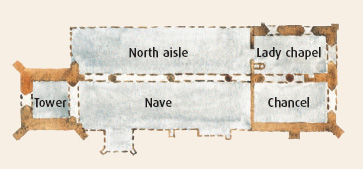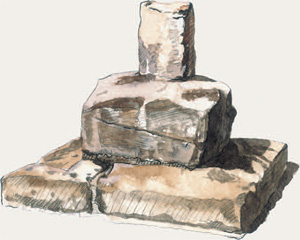Beginnings

Here are the remains of the original
St Augustine’s church, which became the parish
church in the 12th century. These remains have
come to be known as the Old Chancel.
The 12th-century church had just a nave and a
chancel. A lady chapel was added in the
13th century, and a tower in the 14th. A north
aisle was added, too. By the 19th century the
church had become too small for the town’s
growing population and was in a poor state of
repair. A new St Augustine’s, which was
dedicated in January 1923, was built on a plot
of land opposite.

The original St Augustine’s Church has changed little since this
sepia drawing of the church was made by J. Buckler in 1845.
Courtesy of the Trustees of the William Salt Library, Stafford
Shortly afterwards, the nave, north aisle, porch
and vestry of the original church were
demolished. The tower, arcade, lady chapel and
chancel are all that remain.
Plan of the original St Augustine’s Church Lady chapel
The nave is where people gathered for worship. In the chancel
and lady chapel is a sedile, which is a recess in the wall where
the priest sat during a service – this remains today.
The lady chapel and chancel are not normally accessible to
visitors.

The churchyard
In the churchyard you can find the remains of a
late 14th-century cross. Before the Reformation in
the 16th century it would have served as a single
memorial to everyone buried here. Much of the
stepped base is now below ground level but you
can see the deep recess at its top. This is where a
pentient (a person who repents their sins) would
have knelt.
The graveyard was landscaped in 1974 and the
displaced gravestones now pave the area where
the nave and north aisle once stood.

|
The tomb of the two sisters
To the east of the chancel is the unusual tomb of two sisters – Elizabeth Cuting, who died in 1695, and Emma Hollinhurst, who died in 1696. On its top are carved effigies of two figures, each tied at the top and bottom in a shroud. These curious
effigies are behind a local legend that the sisters were buried alive in sacks by Oliver Cromwell – despite Cromwell having died earlier, in 1658.
The true story of the tomb is connected to a Parliamentary Act of 17 years earlier, which required corpses to be buried in wool. These ladies, among others, preferred to be buried in linen, and defied the Act, as the burial register shows.
Defiance would have resulted in a fine.
At one end of the tomb is a skull and cross bones, a symbol that signified mortality. This was a common adornment on tombs at the time.


|
|
A lancet window is narrow,
with a pointed arch |
|
|
Courtesy of the Trustees of the William Salt Library, Stafford |
Records show there was a church in
Rugeley in 1189. Other evidence
suggests the church may have been
built earlier in around 1150, possibly
under the direction of the De Puys
family, who were local landowners
at that time.
In the south wall of the 12thcentury
chancel you can find the
walled-up remains of a priest’s
door, a late 13th-century
window and a lancet window
containing 14th-century glass.
The large east window of the
chancel is a late Victorian
replacement of earlier windows.
When the main body of the church
was demolished, several memorials
were moved into the lady chapel for
preservation. The fine memorial to
John Weston dating from 1566, is one
of several dedicated to members of
the Weston family. The Westons were
a prominent family in the area. At one
time they held the manor of Hagley,
as well as land in Rugeley and
Brereton. The lady chapel also
contains memorials to the Landor
family. A large and elaborate
memorial with coats of arms is to
Thomas Landor, who died in 1670.
This 1836 pen and ink drawing
depicts one of the monuments
to the Weston family now kept
in the lady chapel. It shows a
memorial to Rafe Weston, who
died in 1605.
|
Six bells were cast in 1706, by the Rudhall family of Gloucester.
They were later transferred to the new St Augustine’s church,
where they can still be heard.

A pen and ink drawing from 1835 depicting a south
east view of the church
Courtesy of the Trustees of the William Salt Library, Stafford
|









